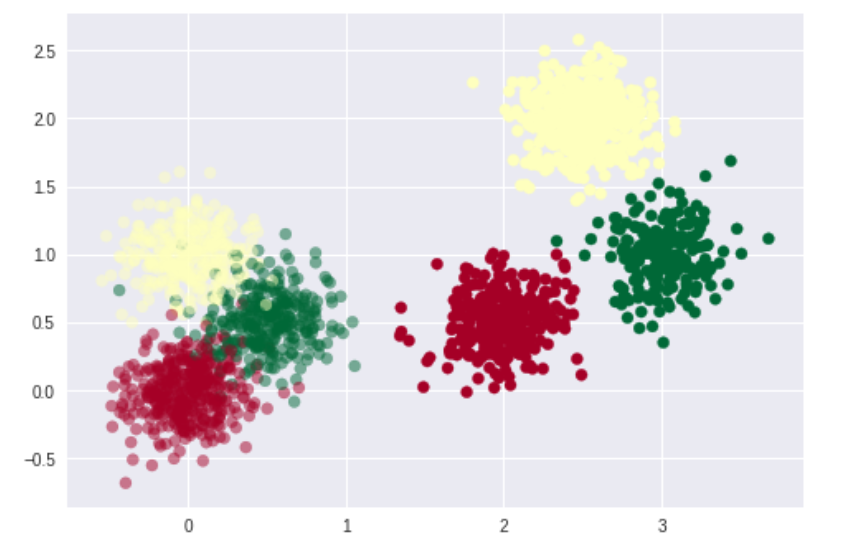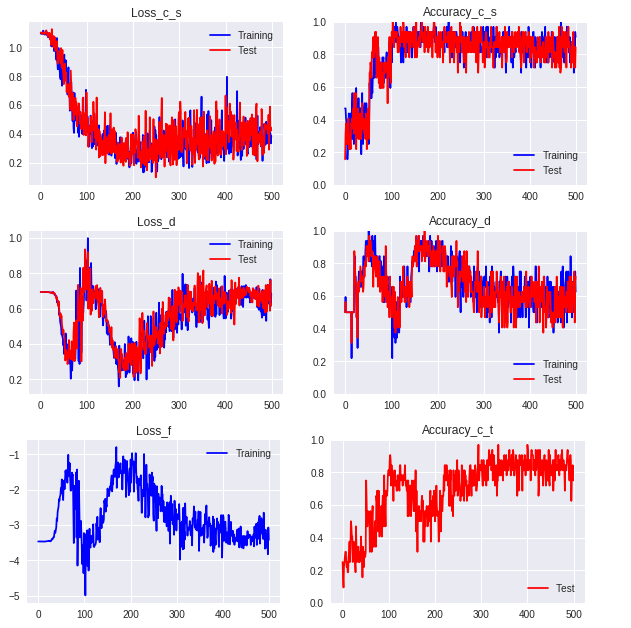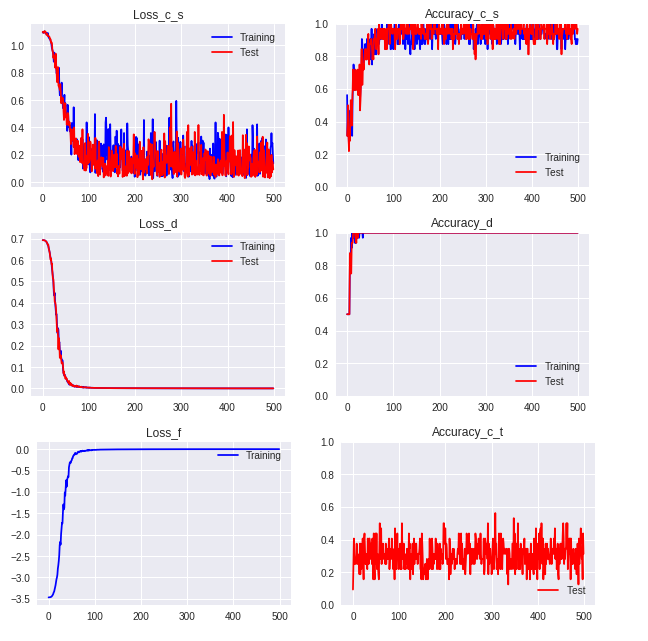# Adversarial Discriminative Domain Adaptation and DANN
class DA():
def __init__(self):
pass
def weight_variable(self, name, shape):
initializer = tf.truncated_normal_initializer(mean = 0.0, stddev = 0.01, dtype = tf.float32)
return tf.get_variable(name, shape, initializer = initializer)
def bias_variable(self, name, shape):
initializer = tf.constant_initializer(value = 0.0, dtype = tf.float32)
return tf.get_variable(name, shape, initializer = initializer)
def f_extractor_s(self, x, n_in, n_units, keep_prob, reuse = False):
with tf.variable_scope('f_extractor_s', reuse = reuse):
w = self.weight_variable('w', [n_in, n_units])
b = self.bias_variable('b', [n_units])
f = tf.matmul(x, w) + b
# batch norm
#batch_mean, batch_var = tf.nn.moments(f, [0])
#f = (f - batch_mean) / (tf.sqrt(batch_var) + 1e-10)
# dropout
#f = tf.nn.dropout(f, keep_prob)
# relu
f = tf.nn.relu(f)
# leaky relu
#f = tf.maximum(0.2 * f, f)
return f
def f_extractor_t(self, x, n_in, n_units, keep_prob, reuse = False):
with tf.variable_scope('f_extractor_t', reuse = reuse):
w = self.weight_variable('w', [n_in, n_units])
b = self.bias_variable('b', [n_units])
f = tf.matmul(x, w) + b
# batch norm
#batch_mean, batch_var = tf.nn.moments(f, [0])
#f = (f - batch_mean) / (tf.sqrt(batch_var) + 1e-10)
# dropout
#f = tf.nn.dropout(f, keep_prob)
# relu
f = tf.nn.relu(f)
# leaky relu
#f = tf.maximum(0.2 * f, f)
return f
def classifier_d(self, x, n_units_f, n_units_d, n_domains, keep_prob, reuse = False):
with tf.variable_scope('classifier_d', reuse = reuse):
w_1 = self.weight_variable('w_1', [n_units_f, n_units_d])
b_1 = self.bias_variable('b_1', [n_units_d])
d = tf.matmul(x, w_1) + b_1
# batch norm
#batch_mean, batch_var = tf.nn.moments(d, [0])
#d = (d - batch_mean) / (tf.sqrt(batch_var) + 1e-10)
# relu
d = tf.nn.relu(d)
# dropout
#d = tf.nn.dropout(d, keep_prob)
w_2 = self.weight_variable('w_2', [n_units_d, n_domains])
b_2 = self.bias_variable('b_2', [n_domains])
d = tf.matmul(d, w_2) + b_2
logits = d
return logits
def classifier_c(self, x, n_units_f, n_units_c, n_classes, keep_prob, reuse = False):
with tf.variable_scope('classifier_c', reuse = reuse):
w_1 = self.weight_variable('w_1', [n_units_f, n_units_c])
b_1 = self.bias_variable('b_1', [n_units_c])
l = tf.matmul(x, w_1) + b_1
# batch norm
#batch_mean, batch_var = tf.nn.moments(l, [0])
#l = (l - batch_mean) / (tf.sqrt(batch_var) + 1e-10)
# relu
l = tf.nn.relu(l)
# dropout
#l = tf.nn.dropout(l, keep_prob)
w_2 = self.weight_variable('w_2', [n_units_c, n_classes])
b_2 = self.bias_variable('b_2', [n_classes])
l = tf.matmul(l, w_2) + b_2
logits = l
return logits
def gradient_reversal(self, f, lam, n_units_f, batch_size):
i = tf.ones(shape = [batch_size, n_units_f], dtype = tf.float32)
return - lam * i + tf.stop_gradient(f + lam * i)
def loss_cross_entropy(self, y, t):
cross_entropy = - tf.reduce_mean(tf.reduce_sum(t * tf.log(tf.clip_by_value(y, 1e-10, 1.0)), axis = 1))
return cross_entropy
def accuracy(self, y, t):
correct_preds = tf.equal(tf.argmax(y, axis = 1), tf.argmax(t, axis = 1))
accuracy = tf.reduce_mean(tf.cast(correct_preds, tf.float32))
return accuracy
def training(self, loss, learning_rate, var_list):
optimizer = tf.train.AdamOptimizer(learning_rate = learning_rate)
train_step = optimizer.minimize(loss, var_list = var_list)
return train_step
def training_gd(self, loss, learning_rate, var_list):
#optimizer = tf.train.AdamOptimizer(learning_rate = learning_rate)
optimizer = tf.train.GradientDescentOptimizer(learning_rate = learning_rate)
train_step = optimizer.minimize(loss, var_list = var_list)
return train_step
def training_clipped(self, loss, learning_rate, clip_norm, var_list):
optimizer = tf.train.AdamOptimizer(learning_rate = learning_rate)
grads_and_vars = optimizer.compute_gradients(loss, var_list = var_list)
clipped_grads_and_vars = [(tf.clip_by_norm(grad, clip_norm = clip_norm), \
var) for grad, var in grads_and_vars]
train_step = optimizer.apply_gradients(clipped_grads_and_vars)
return train_step
def fit(self, x_s_train, x_s_test, y_s_train, y_s_test, d_s_train, d_s_test, \
x_t_train, x_t_test, y_t_train, y_t_test, d_t_train, d_t_test, \
n_in, n_units_f, n_units_d, n_domains, n_units_c, n_classes, lam, \
learning_rate, n_iter, batch_size, show_step, is_saving, model_path):
tf.reset_default_graph()
x_s = tf.placeholder(shape = [None, n_in], dtype = tf.float32)
y_s = tf.placeholder(shape = [None, n_classes], dtype = tf.float32)
d_s = tf.placeholder(shape = [None, n_domains], dtype = tf.float32)
x_t = tf.placeholder(shape = [None, n_in], dtype = tf.float32)
y_t = tf.placeholder(shape = [None, n_classes], dtype = tf.float32)
d_t = tf.placeholder(shape = [None, n_domains], dtype = tf.float32)
keep_prob = tf.placeholder(shape = [], dtype = tf.float32)
feat_s = self.f_extractor_s(x_s, n_in, n_units_f, keep_prob, reuse = False)
#feat_t = self.f_extractor_t(x_t, n_in, n_units_f, keep_prob, reuse = False) # for ADDA
feat_t = self.f_extractor_s(x_t, n_in, n_units_f, keep_prob, reuse = True) # for DANN
feat = tf.concat([feat_s, feat_t], axis = 0)
d = tf.concat([d_s, d_t], axis = 0)
logits_d = self.classifier_d(feat, n_units_f, n_units_d, n_domains, keep_prob, reuse = False)
probs_d = tf.nn.softmax(logits_d)
loss_d = self.loss_cross_entropy(probs_d, d)
logits_c_s = self.classifier_c(feat_s, n_units_f, n_units_c, n_classes, keep_prob, reuse = False)
probs_c_s = tf.nn.softmax(logits_c_s)
loss_c_s = self.loss_cross_entropy(probs_c_s, y_s)
logits_c_t = self.classifier_c(feat_t, n_units_f, n_units_c, n_classes, keep_prob, reuse = True)
probs_c_t = tf.nn.softmax(logits_c_t)
loss_f = - lam * loss_d
var_list_f_s = tf.trainable_variables('f_extractor_s')
var_list_f_t = tf.trainable_variables('f_extractor_t')
var_list_d = tf.trainable_variables('classifier_d')
var_list_c = tf.trainable_variables('classifier_c')
var_list_f_c = var_list_f_s + var_list_c
#train_step_f = self.training(loss_f, learning_rate, var_list_f_t) # for ADDA
train_step_f = self.training(loss_f, learning_rate, var_list_f_s) # for DANN
train_step_d = self.training(loss_d, learning_rate, var_list_d)
train_step_f_c = self.training(loss_c_s, learning_rate, var_list_f_c)
acc_d = self.accuracy(probs_d, d)
acc_c_s = self.accuracy(probs_c_s, y_s)
acc_c_t = self.accuracy(probs_c_t, y_t)
init = tf.global_variables_initializer()
saver = tf.train.Saver()
with tf.Session() as sess:
sess.run(init)
history_loss_c_s_train = []
history_loss_c_s_test = []
history_acc_c_s_train = []
history_acc_c_s_test = []
history_loss_c_t_test = []
history_acc_c_t_test = []
history_loss_d_train = []
history_loss_d_test = []
history_acc_d_train = []
history_acc_d_test = []
history_loss_f_train = []
history_loss_f_test = []
for i in range(n_iter):
# Training
# class classification for f_s and c
rand_index = np.random.choice(len(x_s_train), size = batch_size)
x_batch = x_s_train[rand_index]
y_batch = y_s_train[rand_index]
feed_dict = {x_s: x_batch, y_s: y_batch, keep_prob: 1.0}
sess.run(train_step_f_c, feed_dict = feed_dict)
temp_loss_c_s = sess.run(loss_c_s, feed_dict = feed_dict)
temp_acc_c_s = sess.run(acc_c_s, feed_dict = feed_dict)
history_loss_c_s_train.append(temp_loss_c_s)
history_acc_c_s_train.append(temp_acc_c_s)
if (i + 1) % show_step == 0:
print ('-' * 100)
print ('Iteration: ' + str(i + 1) + \
' Loss_c: ' + str(temp_loss_c_s) + ' Accuracy_c: ' + str(temp_acc_c_s))
# domain classification for f_t and d
rand_index = np.random.choice(len(x_s_train), size = batch_size //2)
x_batch_s = x_s_train[rand_index]
d_batch_s = d_s_train[rand_index]
rand_index = np.random.choice(len(x_t_train), size = batch_size //2)
x_batch_t = x_t_train[rand_index]
d_batch_t = d_t_train[rand_index]
feed_dict = {x_s: x_batch_s, d_s: d_batch_s, x_t: x_batch_t, d_t: d_batch_t, keep_prob: 1.0}
sess.run(train_step_f, feed_dict = feed_dict)
sess.run(train_step_d, feed_dict = feed_dict)
temp_loss_f = sess.run(loss_f, feed_dict = feed_dict)
temp_loss_d = sess.run(loss_d, feed_dict = feed_dict)
temp_acc_d = sess.run(acc_d, feed_dict = feed_dict)
history_loss_f_train.append(temp_loss_f)
history_loss_d_train.append(temp_loss_d)
history_acc_d_train.append(temp_acc_d)
if (i + 1) % show_step == 0:
print ('-' * 100)
print ('Iteration: ' + str(i + 1) + \
' Loss_d: ' + str(temp_loss_d) + ' Accuracy_d: ' + str(temp_acc_d))
# Test
# class classificatin for s
rand_index = np.random.choice(len(x_s_test), size = batch_size)
x_batch = x_s_test[rand_index]
y_batch = y_s_test[rand_index]
feed_dict = {x_s: x_batch, y_s: y_batch, keep_prob: 1.0}
temp_loss_c_s = sess.run(loss_c_s, feed_dict = feed_dict)
temp_acc_c_s = sess.run(acc_c_s, feed_dict = feed_dict)
history_loss_c_s_test.append(temp_loss_c_s)
history_acc_c_s_test.append(temp_acc_c_s)
# class classificatin for t
rand_index = np.random.choice(len(x_t_test), size = batch_size)
x_batch = x_t_test[rand_index]
y_batch = y_t_test[rand_index]
feed_dict = {x_t: x_batch, y_t: y_batch, keep_prob: 1.0}
temp_acc_c_t = sess.run(acc_c_t, feed_dict = feed_dict)
history_acc_c_t_test.append(temp_acc_c_t)
# domain classification for f and d
rand_index = np.random.choice(len(x_s_test), size = batch_size //2)
x_batch_s = x_s_test[rand_index]
d_batch_s = d_s_test[rand_index]
rand_index = np.random.choice(len(x_t_test), size = batch_size //2)
x_batch_t = x_t_test[rand_index]
d_batch_t = d_t_test[rand_index]
feed_dict = {x_s: x_batch_s, d_s: d_batch_s, x_t: x_batch_t, d_t: d_batch_t, keep_prob: 1.0}
temp_loss_f = sess.run(loss_f, feed_dict = feed_dict)
temp_loss_d = sess.run(loss_d, feed_dict = feed_dict)
temp_acc_d = sess.run(acc_d, feed_dict = feed_dict)
history_loss_f_test.append(temp_loss_f)
history_loss_d_test.append(temp_loss_d)
history_acc_d_test.append(temp_acc_d)
print ('-' * 100)
fig = plt.figure(figsize = (10, 3))
ax1 = fig.add_subplot(1, 2, 1)
ax1.plot(range(n_iter), history_loss_c_s_train, 'b-', label = 'Training')
ax1.plot(range(n_iter), history_loss_c_s_test, 'r-', label = 'Test')
ax1.set_title('Loss_c_s')
ax1.legend(loc = 'upper right')
ax2 = fig.add_subplot(1, 2, 2)
ax2.plot(range(n_iter), history_acc_c_s_train, 'b-', label = 'Training')
ax2.plot(range(n_iter), history_acc_c_s_test, 'r-', label = 'Test')
ax2.set_ylim(0.0, 1.0)
ax2.set_title('Accuracy_c_s')
ax2.legend(loc = 'lower right')
fig = plt.figure(figsize = (10, 3))
ax1 = fig.add_subplot(1, 2, 1)
ax1.plot(range(n_iter), history_loss_d_train, 'b-', label = 'Training')
ax1.plot(range(n_iter), history_loss_d_test, 'r-', label = 'Test')
ax1.set_title('Loss_d')
ax1.legend(loc = 'upper right')
ax2 = fig.add_subplot(1, 2, 2)
ax2.plot(range(n_iter), history_acc_d_train, 'b-', label = 'Training')
ax2.plot(range(n_iter), history_acc_d_test, 'r-', label = 'Test')
ax2.set_ylim(0.0, 1.0)
ax2.set_title('Accuracy_d')
ax2.legend(loc = 'lower right')
fig = plt.figure(figsize = (10, 3))
ax1 = fig.add_subplot(1, 2, 1)
ax1.plot(range(n_iter), history_loss_f_train, 'b-', label = 'Training')
ax1.set_title('Loss_f')
ax1.legend(loc = 'upper right')
ax2 = fig.add_subplot(1, 2, 2)
ax2.plot(range(n_iter), history_acc_c_t_test, 'r-', label = 'Test')
ax2.set_ylim(0.0, 1.0)
ax2.set_title('Accuracy_c_t')
ax2.legend(loc = 'lower right')
plt.show()


